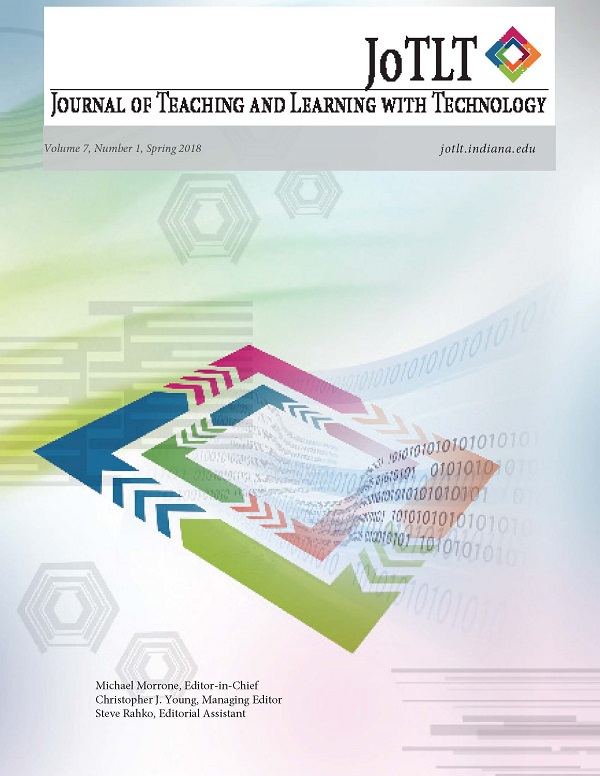An Educational Paradigm in the Midst of Shifting: Students’ and Professors’ Attitudes toward Classroom Technology
Main Article Content
Abstract
Many community college educators struggle with the notion of technology as
integral to classroom learning, concerned about changing the very nature of what classroom learning means. For students, there are similar concerns regarding classroom experience, especially if students come from different educational backgrounds, generations, or levels of technological expertise. This qualitative research study compares student and professor experiences of classroom-specific technology use, and findings indicate convergent and divergent themes among students and professors specific to their classroom technology experiences. Students and professors agree that technology should be used in classrooms, despite sometimes hindering creativity and becoming a distraction. Students and professors disagreed in their satisfaction with amounts of classroom technology use and assurance in the efficacy of that technology use. These findings provide valuable insights and fundamental guiding principles for assessing the relationship between users and classroom technology.
Downloads
Article Details
- Authors retain copyright and grant the Journal of Teaching and Learning with Technology (JoTLT) right of first publication with the work simultaneously licensed under a Creative Commons Attribution License, (CC-BY) 4.0 International, allowing others to share the work with proper acknowledgement and citation of the work's authorship and initial publication in JoTLT.
- Authors are able to enter separate, additional contractual agreements for the non-exclusive distribution of the journal's published version of the work (e.g., post it to an institutional repository or publish it in a book), with an acknowledgement of its initial publication in JoTLT.
- In pursuit of manuscripts of the highest quality, multiple opportunities for mentoring, and greater reach and citation of JoTLT publications, JoTLT encourages authors to share their drafts to seek feedback from relevant communities unless the manuscript is already under review or in the publication queue after being accepted. In other words, to be eligible for publication in JoTLT, manuscripts should not be shared publicly (e.g., online), while under review (after being initially submitted, or after being revised and resubmitted for reconsideration), or upon notice of acceptance and before publication. Once published, authors are strongly encouraged to share the published version widely, with an acknowledgement of its initial publication in JoTLT.
References
Avila, R. A., Biner, P. M., Bink, M. L., & Dean, R. S. (1995). Course materials presentation using videobased technologies: An evaluative study of college student performance and attitudes. Psychology in the Schools, 32 (1), 38-45.
Bunce, D. M., Flens, E. A., & Neiles, K. Y. (2010). How long can students pay attention in class? A study of student attention decline using clickers. Journal of Chemistry Education, 87 (12), 1438-1443.
Courts, B., & Tucker, J. (2012). Using technology to create a dynamic classroom experience. Journal of College Teaching & Learning, 9 (2), 121-128.
Dahlstrom, E. (2012). ECAR study of undergraduate students and Information technology (research report). EDUCASE Center for Applied Research, Louisville, CO.
Efaw, J., Hampton, S., & Martinez, S. (2004). Teaching and learning with laptop computers in the classroom. Education Quarterly, 27 (3), 10–18.
Furr, P. F., Ragsdale, R., & Horton, S. G. (2005). Technology’s nonneutrality: past lessons can help guide today’s classrooms. Journal of Education and Information Technologies, 10, 277 287.
Garza, G. (2004). Thematic moment analysis: A didactic application of a procedure for phenomenological analysis of narrative data. The Humanistic Psychologist, 32 (2), 120-168.
Gu, X., Zhu, Y. & Guo, X (2013). Meeting the “Digital Natives”: Understanding the acceptance of technology in classrooms. Educational Technology & Society, 16 (1), 392–402.
Guzman, A., & Nussbaum, M. (2009). Teaching competencies for technology integration in the classroom. Journal of Computer Assisted Learning, 25, 453–469.
Jacobsen, D. M. (1998). Adoption patterns of faculty who integrate computer technology for teaching and learning in higher education. In proceedings of the Ed-Media and Ed-Telecom 98: World Conference on Educational Multimedia and Hypermedia & World Conference on Educational Telecommunications (2-9), Freiburg, Germany.
Lachs, V. (2002). Book review: Making multimedia in the classroom: A teachers’ guide. Interactive Learning Environments, 10 (3), 293.
Levin, T., & Wadmany, R. (2008). Teachers’ views on factors affecting effective integration of information technology in the classroom: Developmental scenery. Journal of Technology and Teacher Education,16 (2), 233-263.
Mackinnon G. R., & Vibert C. (2002). Judging the constructive impacts of communication education study: A business education study. Journal of Education and Information Technologies, 7, 127–135.
Mayer, R.E. (2005). The Cambridge handbook of multimedia learning. New York: Cambridge University Press.
Nelson, T.F.L., & Kuh, G.D. (2005). Student experiences with information technology and their relationship to other aspects of student engagement. Research in Higher Education, 46, 211–233.
Peluchette, J.V., & Rust, K.A. (2005). Technology use in the classroom: Preferences of management faculty members. Journal of Education for Business, 80 (4), 200-205.
Prensky, M. (2001). Digital natives, digital immigrants. On the Horizon, 9 (5),1–6.
Rutherford, L.H., & Grana, S. H. (1995). Retrofitting academe: Adapting faculty attitudes and practices to technology. T H E Journal (Technological Horizons in Education), 23 (2), 82-87.
Shank, P (2005). The value of multimedia in learning. San Jose, CA: Adobe Systems Incorporated.
Spinelli, M.A. (2001). The use of technology in teaching business statistics. Journal of Education for Business, 77, 41–44.
Voogt, J., & Pelgrum, H. (2005). ICT and curriculum change. Human Technology, 1 (2), 157 175.
Wertz, F. J., Charmaz, K., McMullen, L., Josselson, R., Anderson, R., & McSpadden, E. (2011). Five ways of doing qualitative analysis: Phenomenological psychology, grounded theory, discourse analysis, narrative research, and intuitive inquiry. New York: Guilford Press.
